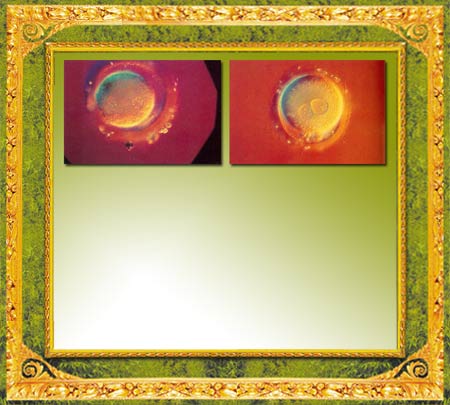The surface of a typical cell is not smooth, but rough. Most cells make contact with one another by means of micro-protrusions on their surfaces known as phyllopods, which are generally no longer than 0.1 microns in length and cover no more than 1/100th of a square micron. The cell uses these micro-protrusions as if they were fingers, to discover its environment and feel the surfaces of other nearby cells.
 |
| The lipid bilayer ... ideally and uniquely suited for the cell to carry out its designated task of building a biosphere of multi cellular life. Michael Denton |
Binding to another cell takes place as a result of special molecules on these micro-protrusions. Binding molecules, present in pairs, bind with their mutually complementary surfaces. Proteins apply the lock-and-key recognition principle they use to recognize substances. The bond between two binding molecules is known as the affinity link, whose strength consists of the totality of various weak chemical bonds that attach two molecules together.
The external surfaces of cells are negatively charged. For that reason, cells repel each other electrostatically. Under these conditions, it would appear impossible for them to remain in physical contact with one another. But because of the cell membrane's special Creation, cells are able to do just that. Along with a decrease in the field of contact in these micro-protrusions in the cell membrane, the repellent effect here is also reduced and ceases to represent any obstacle.
The binding of cells by micro-protrusions also plays an important role in the cell's direction-finding. For example, cells migrating in the body of a developing embryo adhere to a large number of other cells until they find their intended destination. They thus open the path before them by repelling other cells and continue to extend these protrusions in many directions until the correct contact is made. If a cell did not possess the ability to extend these protrusions, then it would be as impossible for it to find its way, no more than a human can do so in the dark without using his hands. Here, however, the wealth of Allah's knowledge again reveals the perfection of the Creation in the entities He has created.
 | A. A fibroblast seen under electron micrography |
| Cells attach to one another and find their way through micro-protrusions known as phyllopods. One cell recognizes another and is capable of selecting it to attach to it is a miraculous phenomenon. For example, in order to constitute a kidney, a kidney cell binds to other kidney cells. Never, however, does a kidney cell attach to a blood cell or a liver cell. How does this tiny structure know which cells to attach to, in order to form a kidney? The knowledge of Allah, as manifested in the cell, is sufficient to fill countless volumes. | |
To establish an affinity link between cells, the distance between the surfaces of the two complementary adhering molecules must be less than 1 nanometer, and they must be correctly aligned. It is difficult for these conditions to be met, yet binding still takes place, even if the links in the cell membrane not approach one another to the requisite extent. These links are strong enough to bear a 40-nanogram weight (1 nanogram = 1 billionth of a gram). If the affinity links between cells were not that strong, it would be exceedingly difficult for one cell to bind to any other.
Many cells can establish bonds to other cells by means of a single protrusion; this can constitute a permanent bond by means of two affinity links. Were the affinity links in this bonding system a few times weaker, the cell could not attach to another. In addition, proteins would not be stable, and enzymes would not bind to the relevant substances. If these links were stronger, then it would be very hard for bonded cells to separate from one another. As you have seen, there is a most delicate balance for one cell to be able to bind to another, and it is impossible for that equilibrium to have attained its ideal form by trial and error.
 | |
| … Not even the smallest speck eludes your Lord, either on Earth or in heaven. Nor is there anything smaller than that, or larger, which is not in a Clear Book. |
If cells could not move, life would be impossible. During crawling, the cell extends fan-like protrusions known as lamellae that permit a temporary attachment to the adjacent surface and slide forward, dragging the cell behind them. This process is made possible by the cell's constantly changing shape. To do so, that the cytoplasm inside the cell wall must have the property of a semi-solid and be adhesive in such a way as to form protrusions extending to the outside. But at the same time, the inside of the cell must also have solid structural elements to constitute a flexible skeleton.
Evidently, the cell's crawling ability depends on the cytoplasm being readily deformable so that the cell's interior can be drawn into an advancing protrusion. If too viscous, the cell's contents would be immobilized. The cell must be able to reversibly adhere to a substratum, and, as you just saw, the property of adhesion depends on the strength of weak chemical bonds. The cell must be able to generate enough traction to pull its mechanically rigid scaffold. If the viscosity of water, the energy levels of weak chemical bonds and the power of the traction forces were all slightly different from what they are, such crawling would likely be impossible.71 The cell's propulsive ability plays a vital role in all stages of bodily development.
 | 1. 0 minute |
| The above micrographics show the movement of a fibroblast cell on glass. One reason you are able to read this book is this ability of your cells to move. | |
| If they did not move towards specific objectives, then it would be impossible for them to combine to produce an organ, and life would be impossible. A great many interconnected details permit cells to move, such as the density of the intracellular fluid and the elasticity of the cell membrane. This is an example of the knowledge of Allah manifested in small details. | |
The cell's crawling and binding also depend on its dimensions. If cells were 10 times smaller than they are, then their crawling would become impossible: It would be very difficult for the systems inside the cell to fit into a volume just 1/1000th of its size. Moreover, since the surface of the cell would also be 100 times smaller, the number of molecules able to attach to its surface would be reduced. It would be very difficult, too, for such small cells to form the complex protrusions that let them feel their way, and it would be impossible for the cell to perform vital functions such as bonding and crawling.
Dr. Juliet Lee of the Connecticut University Molecular and Cell Biology Department made the following comment about the cell's ability to move in the wake of her research published in Nature magazine:
A lot of people don't realize that many cells are not stationary but can travel from one place to another. . . If cells could not move, none of us would exist. Embryos would not develop, wounds would never heal... When cells are stretched, such as when they're going forward and their back end gets stuck, calcium channels along the sides open to admit more calcium ions. This boosts the cell's motility so that the back end is pulled away from whatever it's been stuck on, and it can move forward again... We also found that if we prevented cells from exhibiting these pulses of calcium, the cells became stuck so they could no longer pull their back edges in. ...As soon as the rear of the cell retracts, stretching is released, the calcium channels close and the level of calcium drops back. 72
 |
| The 100 trillion or cells currently comprising your body came into being from the division of a single cell—itself the product of an egg cell and a sperm cell. The construction of your body, starting from a single cell, is just one of the marvels of Allah's Creation. The human body has a perfect and inimitable complexity. |
The cell's abilities to selectively bind and to crawl depend on the features of its cytoplasm and the structure of the cell membrane. Cytoplasm has a most plastic and mobile structure, ideally suited to crawling and binding. The cell's abilities to move and bind are possible only when cytoplasm possesses exactly the proper characteristics. DNA, protein, sugar and lipids—the basic compounds of life—also possess exactly the right structure and need to be present in the right proportions for the cell to maintain its activities and multiply. As a result of this, however, the cells are able to move and bind and thus, make larger organisms possible. In short, there is no room for gradual development in the structure of cells, as Darwinists claim. On the contrary, all of the cell's components and features constitute a whole, possessing a very special structure for the emergence of life.
The famous British mathematician and astronomer Sir Fred Hoyle expressed the impossibility of claims of coincidence:
The notion that not only the biopolymer but operating program of a living cell could be arrived by chance in primordial organic soup here on the Earth is evidently nonsense of a high order. 73
71. Michael J. Denton, Nature's Destiny, New York: The Free Press, , 1998, p. 221.
72. http://www.unc.edu/news/newsserv/research/jul99/jacobson072199.htm
73. Fred Hoyle, "The Big Bang in Astronomy," New Scientist, Vol. 9, 1981, pp. 521, 527.